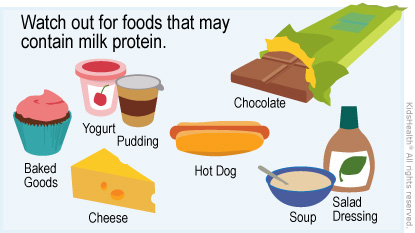Your child has an allergy to cow's milk. After eating or drinking something with milk, your child may get a rash or have nausea, vomiting, wheezing, coughing, or trouble breathing. Milk allergies can be life-threatening for some kids. Follow these instructions to keep your child safe.


Instructions for Food:
Safety Planning:
Epinephrine:


If your child shows signs of anaphylaxis, such as trouble breathing, throat tightness, a combination of two mild symptoms (such as hives with vomiting), or loss of consciousness, follow these steps, in this order:

What causes cow's milk allergy? Most people digest the proteins in milk without any problems. But in kids with cow's milk allergies, the immune system treats the proteins like dangerous invaders and goes into overdrive, causing an allergic reaction.
How do health care providers diagnose cow's milk allergy? To confirm a milk allergy, health care providers ask questions and will do an exam. They may order skin tests and/or blood tests.
What is anaphylaxis? Anaphylaxis is a severe allergic reaction. Someone with anaphylaxis may have trouble breathing or swallowing, may vomit repeatedly, or might pass out. If not treated, anaphylaxis can cause death.
Some kids with milk allergy are at risk for anaphylaxis. If your child is at risk, your health care provider told you this and prescribed epinephrine auto-injectors.
What is epinephrine? Epinephrine is a medicine that treats anaphylaxis. It comes in an auto-injector. When needed, it is injected into the thigh.